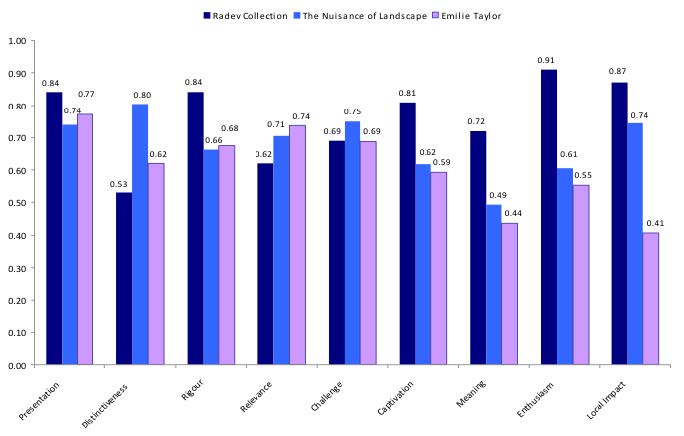‘One event is interesting, after two or three you start to see a trend’
– Jeanette Edgar, Lakeland Arts
In theory at least, as with other big data applications, the more data points an organisation starts to generate over a given period, both in terms of the range of events and audiences evaluated using the metrics, the more insightful comparison and analysis across the data will be.
Lakeland Arts in Cumbria have carried out three evaluations using Culture Counts, and their experience is interesting as to whether more data points across different events opens up new insights, or new ways of thinking about using the resulting data and planning future evaluations.
Lakeland Arts is one of the most significant arts and heritage organisations in the North of
England with a national and international reputation for the quality of its historic buildings, museum and gallery collections and programming. It has a diverse portfolio of attractions: Abbot Hall Art
Gallery and the Museum of Lakeland Life & Industry in Kendal, Blackwell The Arts & Crafts House and the new Windermere Jetty in Bowness. Abbot Hall and Blackwell are Grade 1 Listed Buildings
Lakeland Arts have evaluated three events using the core metrics:
The Radev Collection
The Nuisance of Landscape (a retrospective of Grizedale Arts)
Emilie Taylor (a new ceramic artist)
After their first evaluation – Radev Collection – Jeanette Edgar, Director of Marketing and Communications at Lakeland commented that,
‘The approach showed us straight away the value of the self, peer and public evaluation process – it made us focus on explaining what we really thought this exhibition was aiming to achieve and why. We weren’t particularly challenged by the results (they were what we expected), but we were encouraged by public scores for the local impact question -‘it’s important it’s happening here’ – both because of the high scores and because that question really engaged our audience.’
Figure 1 below shows the public scores for the three exhibitions. The peer results for all three shows were consistently excellent.
Figure 1: Average public scores for Radev Collection, The Nuisance of Landscape and Emilie Taylor

Radev Collection n=114
The Nuisance of Landscape n=183
Emilie Taylor n=83
The Nuisance of Landscape was a completely different type of exhibition: a retrospective of Grizedale Arts both in terms of their creative processes and their work – a bold, striking and challenging exhibition: ‘bright, noisy, brash, which completely transformed the look and feel of the galleries’. Lakeland Arts anticipated it would be challenging for their audiences and that was reflected in the results, which also made the team realise that their interpretation wasn’t as good as it could have been for the exhibition.
The Lakeland Arts team then evaluated a new piece of work by Emilie Taylor, a young ceramicist, exhibited at Blackwell, a nationally important arts and craft house. Lakeland Arts have a commitment to new artists and the work by Emilie Taylor was a challenging, socially engaged piece.
The Blackwell exhibition scored less well than the other two exhibitions – but the team were not concerned by this outcome.
As Jeanette Edgar comments,
‘It told us the interpretation could have been better and it was interesting that it scored very low ‘local impact’ scores – it’s important it’s happening here’ – as we want to bring more of this type of work to our venues. The results are not telling us – don’t do contemporary art in Blackwell -but rather we need to do something like this again, evaluate it, and provide more interpretation about why we’re doing work of this kind in this place. Lower scores doesn’t mean you’ve failed, it’s about how we can improve each time we do it. So this type of evaluation approach encourages us to think through how we make this type of exhibition work well for us and our audiences at our venues, and set ourselves targets and aspirations for when we do this type of work again.’
As Helen Watson, Director of Exhibitions and Collections at Lakeland commented,
‘The experience has highlighted that curators will talk at length to one another, but when it comes to putting the exhibition on the wall there has been a bit of a hole – in terms of getting across more clearly why we are supporting a piece of work, like Emilie Taylor. The results made us talk a lot about why it was received like it was – for example we didn’t say we support young and emerging artists in the interpretation, even though that is at heart of what we do.’
The interesting dynamic about the Lakeland Arts experience is how far the coming together of marketing and commercial staff, working with the curatorial staff in interpreting the results, is something that will be repeated consistently with other arts organisations. Lakeland Arts are keen to try and make sure that each exhibition they do includes the generation of this type of evaluative data. As Jeanette Edgar noted,
‘This will be really working for us when we hear all the curators talking about the results and asking for it as an evaluation mechanism because they want particular insights into particular exhibitions.’
Looking ahead in terms of adoption and use patterns of the method, the key question will be the extent to which cultural organisations find new and insightful ways of using the metrics over time, creating greater depth of insight into their creative practices and audience development activity.
Image credit: Lakeland Arts